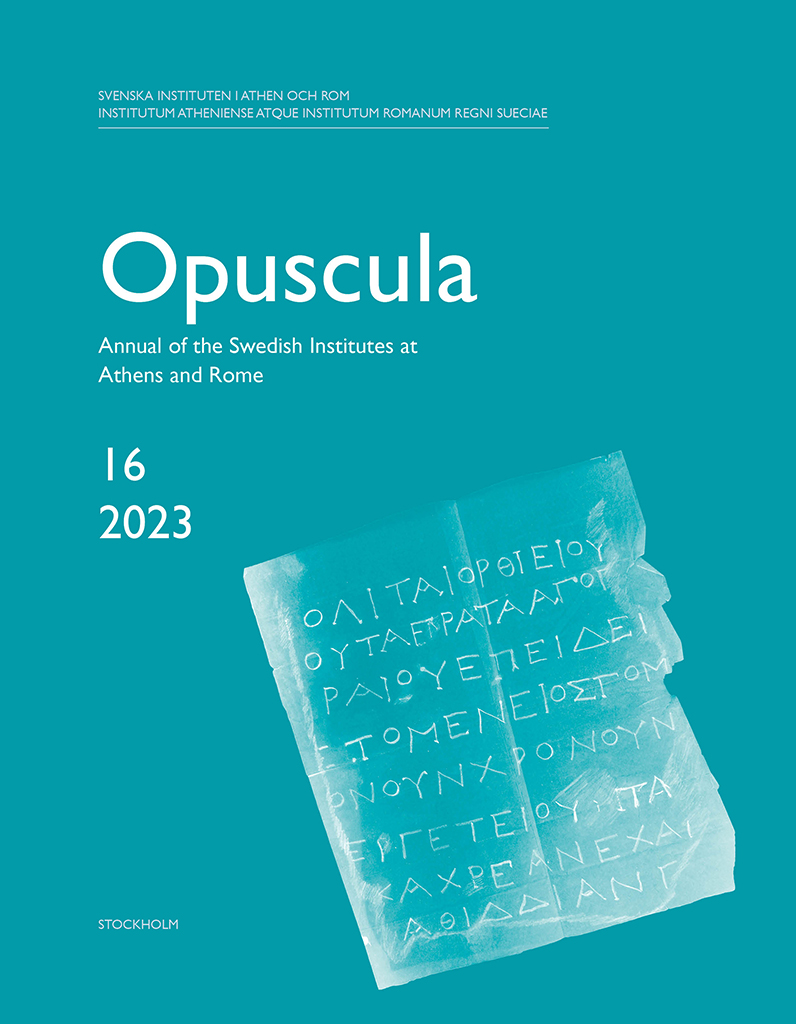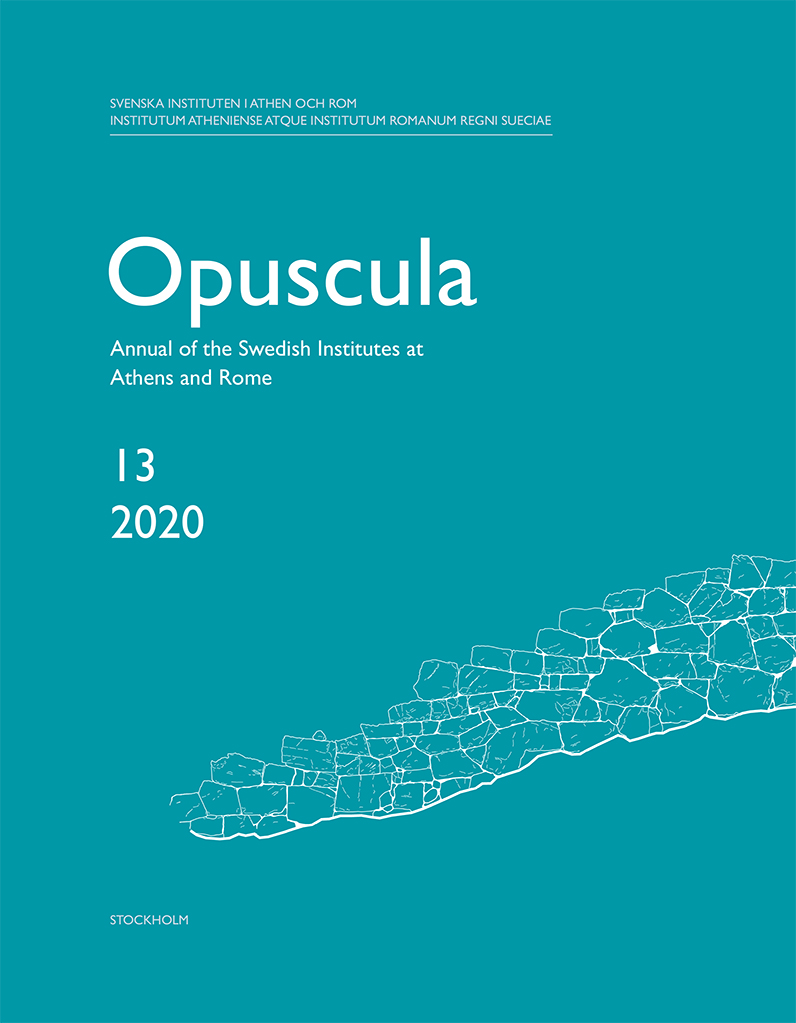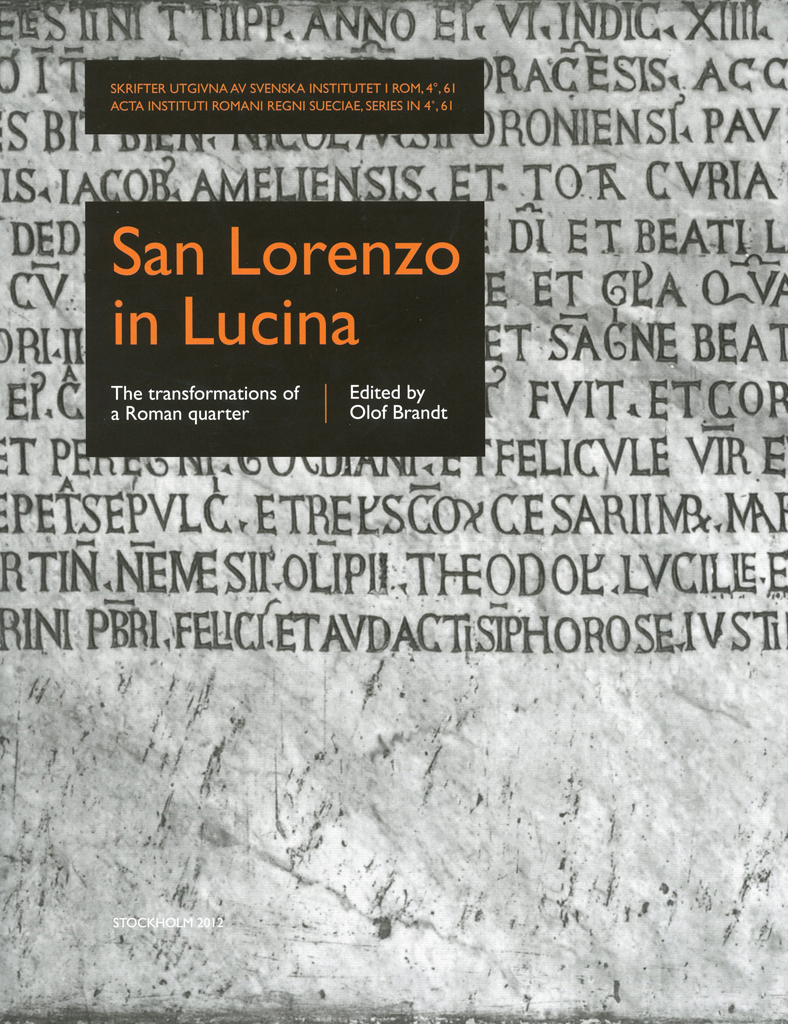Opuscula is published by the Swedish Institutes at Athens and Rome, with the aid of a grant from the Swedish Research Council. Distributed by Eddy.se AB. View journal at ERIH PLUS. All content available with open access. Review article. Gender in ancient Rome: New directions and voices By Lovisa Brännstedt & Lewis Webb Books reviewed R. Ancona & G. Tsouvala, eds., New directions in the study of women in Greco-Roman antiquity, New York: Oxford University Press 2021. xvi + 278 pp., 11 figs, 8 colour pls. ISBN 9780190937638 https://doi.org/10.1093/oso/9780190937638.001.0001 B. Longfellow & M. Swetnam-Burland, eds., Women’s lives, women’s voices. Roman material culture and female agency in the Bay of Naples, Austin: University of Texas Press 2021. 408 pp., 76 figs, 16 colour pls. ISBN 9781477323588 https://doi.org/10.7560/323588 F. Rohr Vio, Powerful matrons. New political actors in the Late Roman Republic, Zaragoza: Prensas de la Universidad de Zaragoza 2022. 236 pp. ISBN 9788413404523 Bibliographical information Lovisa Brännstedt & Lewis Webb, ‘Review article. Gender in ancient Rome: New directions and voices’, Opuscula. Annual of the Swedish Institutes at Athens and Rome (OpAthRom) 16, Stockholm 2023, 249-255. ISSN: 2000-0898. ISBN: 978-91-977799-5-1. Softcover, 268 pages. https://doi.org/10.30549/opathrom-16-11
Opuscula is published by the Swedish Institutes at Athens and Rome, with the aid of a grant from the Swedish Research Council. Distributed by Eddy.se AB. View journal at ERIH PLUS. All content available with open access. Hieronymus Odam, engraved gems and antiquarianism By Paweł Gołyźniak Abstract This article is designed to recover and reconstruct the antiquarian, collecting, and documentary activities of Italian artist Hieronymus Odam (c. 1681–1740) in respect of engraved gems. Odam is primarily recognized as a painter, while his contribution to the development of antiquarianism and collecting of antiquities remains virtually unknown. Odam’s speciality was intaglios and cameos. The recently discovered drawings of gems in the Princes Czartoryski Museum in Kraków, the Kunstbibliothek in Berlin, and the Biblioteca Apostolica Vaticana, as well as archival sources—Odam’s correspondence and two dactyliothecae (those of Pier Leone Ghezzi and James Tassie)—prove that he possessed a considerable number of engraved gems and was one of the experts in this particular field. But above all, Odam documented thousands of engraved gems, notably for Philipp von Stosch, in a very accurate and innovative way, straying from the traditional antiquarian approach. The co-operation between Odam and Stosch resulted in illustrations that were designed to show techniques…
Opuscula is published by the Swedish Institutes at Athens and Rome, with the aid of a grant from the Swedish Research Council. Distributed by Eddy.se AB. View journal at ERIH PLUS. All content available with open access. Memorial sculpture in the Protestant Cemetery at Rome. New discoveries and an inventory of identified works By Nicholas Stanley-Price Abstract The funerary sculpture in the Protestant Cemetery in Rome, the heart of Catholicism, has been little studied. A new inventory of monuments lists over 130 works for which the sculptor, architect or bronze foundry, either Italian or non-Italian, has been identified. Many new identifications, often based on previously unrecorded inscriptions, have brought to light the work of well-documented foreign sculptors who had settled in Rome either temporarily or permanently. Several elaborate monuments were evidently commissions from wealthy relatives or friends of the deceased, but a greater number were contributed by artistic family members or by other fellow artists. In these frequent cases, a desire to commemorate a relative or personal friend, rather than financial gain, would have been the primary motivation. Bibliographical information Nicholas Stanley-Price, ‘Memorial sculpture in the Protestant Cemetery at Rome. New discoveries and an inventory of identified works’, Opuscula. Annual…
Opuscula is published by the Swedish Institutes at Athens and Rome, with the aid of a grant from the Swedish Research Council. Distributed by Eddy.se AB. View journal at ERIH PLUS. All content available with open access. The Basilica Sempronia and the Forum Romanum By Henrik Gerding & Nicolò Dell’Unto Abstract The authors of this paper reinvestigate the remains of the Basilica Sempronia, situated below the Imperial Basilica Julia in Rome. By combining the information from the original excavation with a new 3D digital documentation, new observations are made and previous interpretations reassessed. The present remains are discussed in relation to the contemporary built environment, as well as to preceding and following phases. It is argued that the Basilica Sempronia was an elongated hall with closed lateral walls and interior supports. It was erected on a podium that raised the building above the surrounding streets on all sides except the west. The Augustan renewal of the Basilica Julia entailed vast foundations works, which had a huge impact on the site. However, evidence of an intermediate phase indicates the existence of a building complex that merged the previous basilica with the Tabernae Veteres, partly preserving their original dimensions and orientations. This…
Opuscula is published by the Swedish Institutes at Athens and Rome, with the aid of a grant from the Swedish Research Council. Distributed by Eddy.se AB. View journal at ERIH PLUS. All content available with open access. The Old Cemetery for Foreigners in Rome with a new Inventory of its burials By Nicholas Stanley-Price (Non-Catholic Cemetery for Foreigners, Rome, Italy) Abstract From at least 1716 until formal closure of the Cemetery in 1822, non-Catholic foreigners dying in Rome were usually buried adjacent to the Pyramid of Gaius Cestius in Testaccio. Some 80 stone monuments in the Old Cemetery were systematically recorded in the 1980s. To these can now be added a similar number of burials known from travel accounts and archival sources. This new, combined Inventory of 157 entries provides notes on the life and death in Rome for each individual. Its information modifies current perceptions that the Old Cemetery burials reflect mainly an élite, male population of Grand Tourists and aristocrats. Women are better represented, as are a wide range of professions, crafts, and domestic roles. A reassessment of the Cemetery’s layout leads to conclusions about its original extent, the first appearance of stone memorials in the 1760s, and…
Opuscula is published by the Swedish Institutes at Athens and Rome, with the aid of a grant from the Swedish Research Council. Distributed by Eddy.se AB. View journal at ERIH PLUS. All content available with open access. Power and coinage. The portrait tetradrachms of Eumenes II By Marie-Christine Marcellesi Abstract Among other innovations in coinage, the portrait tetradrachms of Eumenes II testify to the interest that the Attalid king showed in coinage. It is difficult to date these coins using purely numismatic criteria. The generally favoured late dating is based on the notion that this was a short-lived coinage, but it may well have been struck – possibly at intervals – over a relatively long period of Eumenes II’s reign. In this paper I defend an early dating for the starting point of this coinage, in the first half of the reign and even in the first years, before the Treaty of Apamea. The historical context of the rising power of Rome in the Eastern Mediterranean after the Second Macedonian War may explain the original features of this coinage and its iconography, which shows a will to affirm a personal power and also suggests a connection with Rome through the…
Published by the Swedish Institute of Classical Studies in Rome. Distributed by Eddy.se AB. City of the Soul. The literary making of Rome Edited by Sabrina Norlander Eliasson & Stefano Fogelberg Rota Abstract How Rome was experienced and conveyed in travel literature from the centuries preceding and following the period of the Grand Tour is the subject of this book. Its point of departure was the international and interdisciplinary conference The City of the Soul. The literary making of Rome, held at the Swedish Institute in Rome (9–10 September, 2010). The authors of the 13 essays contained in the book examine the writings of both renowned and less known travellers from different countries (Sweden, France, England, United States, etc.). The great variety of angles and perspectives presented in the book depends on the different motives and expectations of the examined authors. Their writings (travelogues, poetry, novels, letters, intimate diaries, etc.) show the Eternal City not only as a topographic reality but also as a complex myth embracing the idea of Western civilisation. Contents Introduction Sabrina Norlander Eliasson & Stefano Fogelberg Rota, ‘The literary making of an eternal city’ Setting the premises Anders Cullhed, ‘“Rome as a trope”. Some early modern…
Opuscula is published by the Swedish Institutes at Athens and Rome, with the aid of a grant from the Swedish Research Council. Distributed by Eddy.se AB. View journal at ERIH PLUS. All content available with open access. The solidus hoard of Casa delle Vestali in context By Svante Fischer Abstract In this paper, I discuss the context of a Late Roman solidus hoard found in the Casa delle Vestali on the Forum Romanum in Rome. The hoard consists of 397 solidi, Late Roman gold coins. Most of the hoard consists of uncirculated solidi struck in the name of the Western Roman emperor Procopius Anthemius (AD 467–472). By means of situating the hoard within the context of the reign of Anthemius and the collapse of the Western Roman Empire, the aim of this paper is to determine if the coins in the Vestal hoard can be related to other contemporary coin hoards by means of numismatic typology; this information could add to our understanding of why Anthemius’ reign is considered such an unmitigated failure and why the Empire collapsed soon after his murder. In this article, the composition of the hoard is examined, and the contents are compared to other contemporary…
Published by the Swedish Institute of Classical Studies in Rome. Distributed by Eddy.se AB. San Lorenzo in Lucina. The transformations of a Roman quarter Edited by Olof Brandt Abstract This volume presents the results of research carried out by the Swedish Institute in Rome in the Roman church of San Lorenzo in Lucina. This research involved the Roman phases of the site and the surrounding quarter. The research began with the 1993–1998 excavation of the baptistery of the Early Christian church, and continued in 2000 with a project which also included other parts, aspects and periods of the site. The papers in this volume shed new light on the Late Roman and post-Antique development of an area which is between Augustan monuments such as the Ara Pacis, the Mausoleum of Augustus, the obelisk and its meridian. The papers include studies on the early 3rd century insula beneath the church, the baptistery and the Early Christian basilica, as well a survey of hagiographic legends, medieval wall-paintings, and other finds such as inscriptions and graffiti, pottery, glass, marble, bones and spolia. Reports on the conservation on fragments of Roman wall-paintings and marble fragments are also included. Contents Barbro Santillo Frizell, ‘Preface’ Olof…
Published by the Swedish Institute of Classical Studies in Rome. Distributed by Eddy.se AB. Via Tiburtina. Space, movement and artefacts in the urban landscape Edited by Hans Bjur & Barbro Santillo Frizell Abstract How can cities integrate historic layers into their urban development? How can tangible and intangible heritages be read, interpreted and utilised in a sustainable city and landscape development? What significance could an ancient road have in this context? These are the overall questions in this book. It contains a number of different approaches to the interaction between the ancient road Via Tiburtina and the surrounding urban landscape east of Rome towards Tivoli, a rich palimpsest of distinguishable interrelated layers created over at least three millennia. One hypothesis being explored is that structures like Via Tiburtina still can determine the morphology of the urban landscape. Settlements, buildings, space, movement and cultural artefacts have therefore come into focus in investigating whether broken connections could be re-established, and thus creating a dialogue between Rome’s earlier epochs and the future. Contents Index map Introduction Hans Bjur & Barbro Santillo Frizell | Ways to urban landscape archaeology Hans Bjur | That’s the way it is Movement Barbro Santillo Frizell | Changing pastures…








